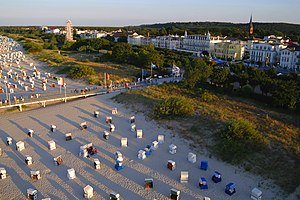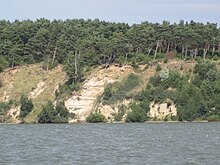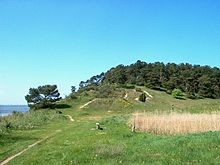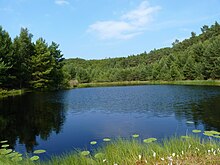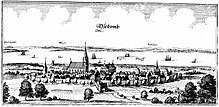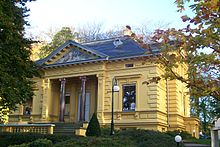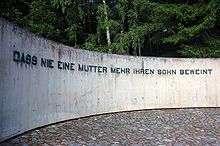Usedom
| Usedom / Uznam | ||
|---|---|---|
| Seebad Ahlbeck with beach, dune and promenade | ||
| Waters | Pomeranian Bay | |
| Geographical location | 53 ° 56 ' N , 14 ° 5' E | |
|
|
||
| length | 66.4 km | |
| width | 23.9 km | |
| surface | 445 km² | |
| Highest elevation |
Golm 69 m |
|
| Residents | 76,500 172 inhabitants / km² |
|
| main place | Świnoujście (Swinoujscie) | |
| Overview map | ||
Usedom ( Polish Uznam , Wendish Uznjöm / Uznjom ) is an island located in the Pomeranian Bay of the southern Baltic Sea , which mostly belongs to Germany and a small part to Poland . It is separated from the mainland by the Peenestrom and the Stettiner Haff and from the neighboring island of Wolin by the Świna (Swine) . Usedom is the second largest German island after Rügen . Until 1945 it belonged to the Prussian province of Pomerania .
Today the larger German part belongs to the state of Mecklenburg-Western Pomerania and is part of the district of Vorpommern-Greifswald . In the eastern - now Polish - part of the West Pomeranian Voivodeship is the port city of Świnoujście (Swinoujscie), where more than half of the island's total population of 76,500 (as of 2014) lives. The largest towns on the German side are Heringsdorf in the east and Zinnowitz in the west of the island.
With an average of 1906 hours of sunshine a year, Usedom is regularly the sunniest area in Germany and the Baltic Sea , which is why tourism marketing also advertises it as a sunny island . The up to 70 m wide, fine sandy beach on the Baltic Sea coast of Usedom stretches 42 km from Peenemünde in the northwest to Świnoujście in the east of the island. With 4.9 million overnight stays (2014), Usedom is the second most popular German holiday island after Rügen. The traffic situation on Usedom is problematic for residents and holidaymakers, especially due to frequent traffic jams and the lack of fast alternatives in the area of rail, bus, ferry and flight connections. The Heringsdorf airport in Zirchow provides scheduled and charter flights to the island. Ferry boats run regularly between the piers and to other destinations .
The name of the island is derived from the city of Usedom . From around 1850 and especially in the last quarter of the 19th century, numerous seaside resorts flourished on the island , which mainly attracted guests from metropolises such as Berlin and Szczecin . Since then, Usedom has been heavily influenced by tourism and , since 1990 , increasingly international . Numerous villas in the style of spa architecture , traditionally built thatched houses , fishermen's cottages and the Ahlbeck pier are evidence of this time .
The island's tourist centers are in the northwest Karlshagen , Trassenheide and Zinnowitz , in the central part of the island the amber baths Koserow , Loddin , Ückeritz and Zempin and in the east the imperial baths Bansin , Heringsdorf and Ahlbeck and Świnoujście. The Europa-Promenade, the longest beach promenade in Europe, stretches over twelve kilometers from Bansin to Świnoujście and is to be extended to Swine .
Geography, geology and climate
Size and location
- Area: 445 km² (German part 373 km² - Polish part 72 km²)
- Population: 76,500 (German part 31,500 - Polish part 45,000); 160 inhabitants / km²
Usedom is located in the southwestern Baltic Sea. The island forms the eastern end of the Western Pomeranian lagoon compensation coast. It is bounded in the west by the Peene River , in the east by the Świna (Swine), in the south by the Stettiner Haff and in the northeast by the Baltic Sea ( Pomeranian Bay ). The islands of Rügen, Ruden and Greifswalder Oie are to the northwest of Usedom, and Wolin to the east . The German part of the island belongs to the district of Vorpommern-Greifswald in the state of Mecklenburg-Western Pomerania. The Polish part belongs to the city of Świnoujście in the West Pomeranian Voivodeship .
The sea side of the island is characterized by a relatively straight compensation coast with a gently sloping chute . In the northeast the coast is flat, from Koserow steep coast dominates with the Streckelsberg in Koserow as the highest point. The side of the island facing the mainland is strongly structured by the Achterwasser , a large lagoon in the Baltic Sea fed by the Peene River , and has several peninsulas and bays. Peninsulas protruding into the backwater are the Lieper Winkel , the Gnitz and the Cosim peninsula . Bays of the backwater are the Krumminer Wiek, the Krienker See, the Balmer See and the Nepperminer See. There are also some small islands in the backwaters: Böhmke , Balmer Werder and, until 2016 connected to the Gnitz by a dam, Görmitz .
Due to the receding of the sea coast, the backwater between Ückeritz and Zinnowitz is only separated from the open Baltic Sea by a narrow spit . The narrowest point is between Koserow and Zempin . It is only about 300 m wide and has been washed over several times in the past centuries by storm floods in the Baltic Sea. B. during the Baltic storm flood in 1872 . By coastal protection measures such as groynes , the wash up of sand was or surf walls and is trying to stop the banks of decline and loss of land.
The north-western part of the island is largely flat, the south-eastern part is characterized by gently rolling hills ("Usedomer Switzerland"). The highest elevations in Usedom are the Streckelsberg in Koserow and in the east of the island the Lange Berg, the Zirowberg, the Kückelsberg and the Golm . These elevations form the old island cores. Between these stretches flat alluvial land, which historically is sediment deposited by ocean currents. In these depressions lie, "often hidden and difficult to access in dense undergrowth, small and large peat, bogs, swamps, reed-surrounded lakes, ponds overgrown with water lilies." The large lakes in the east of the island are the Schmollensee and the Gothensee . Between these two are the large and small crab lakes . To the south of it, in the middle of the Thurbruch , an extensive low moor, is the Kachliner See . Wolgastsee lies east of the Gothensee . Other smaller lakes are the Schloonsee in Bansin, the Wockninsee near Ückeritz and the Kölpinsee in the Loddin district of the same name .
geology
The island is part of a terminal moraine arc , the continuation of which is the island of Wolin. The moraine formed on the forehead of the melting back Scandinavian ice of the Vistula Ice Age about 15,000 years ago. The meltwater flowed south into an ice reservoir that forms the Stettiner Haff , and the lagoon is drained through the former meltwater valleys. With the rise of the Baltic Sea level at the end of the last Ice Age, a compensatory coast was formed due to beach displacement , which consists of long sandy beaches.
The near-surface layers of the island are exclusively geologically young ( Quaternary ) deposits. At a depth of 50 to 100 meters, the Upper Cretaceous is on.
On Usedom there are the boulders typical of former glacier areas . Due to their non-local types of rock, they are direct evidence of glaciation, because the rocks, some of which are several cubic meters in size and several tons in weight , all come from Scandinavia and the bottom of the Baltic Sea and can only have been transported through ice. The boulders often show forms of erosion due to ice transport in the form of scratches and grinding surfaces.
In the Usedom rock garden at the Neu Pudagla Forestry Office , which works closely with the Institute for Geography and Geology at the University of Greifswald , the most important types of boulder are exhibited. Geological features include, for example, a nexosandstone with a volume of around 2.3 m³ and parallel glacier scrapes on the surface, a conglomerate consisting of various rounded pebbles from the surf zone of a beach and a Scolithus sandstone with fossil wormways. The oldest boulder is around two billion years old, the largest weighs around seven tons.
Nature reserves
Even during the GDR era, some areas of Usedom had been declared nature reserves (NSG) and landscape protection areas (LSG), which were gradually expanded. In December 1999, the entire island, including the waters facing the mainland and a small strip of the mainland in the area of the Lubmin seaside resort and the city of Lassan, was officially declared the Usedom Island Nature Park .
Nature reserves (NSG) on Usedom:
- Nature reserve Peenemünder Haken, Struck and Ruden , the oldest NSG in Usedom - designated as early as 1925
- Gnitz peninsula , since 1994, 61 ha
- Wockninsee near Ückeritz, since 1967, 50 ha, partly silted up
- Mümmelkensee , since 1961, 6 ha, moor lake between Schmollensee and the Baltic Sea beach
- Nature reserve peninsula Cosim on Lake Balmer , since 1996, 85 ha
- Vogel Islands Böhmke and Werder in Lake Balmer, since 1967, 118 ha
- Gothensee, since 1967, with 800 hectares the largest NSG on Usedom, with Niedermoor Thurbruch
- Golm , since 1976, 25 ha, highest mountain Usedom (69 m)
- Zerninsee , since 1995, 365 ha, silted up lake and moor on the border with Poland
- Streckelsberg in Koserow, since 1961, 34 ha, highest cliff edge dune on the island (58 m)
- Mellenthiner Os nature reserve , since 1995, 65 ha, ice age hill and moor, Slavic hill fort
- Small Krebssee, since 1996, 45 ha, between Schmollensee and Gothensee
climate
Usedom is the sunniest region in Germany. With an average annual sunshine duration of 1917 hours, the town of Zinnowitz has the most hours of sunshine of all measuring points of the German Weather Service . The mean value in Germany is 1550 hours of sunshine per year.
The annual precipitation in Zinnowitz is 560 mm in the lower third of the measuring points of the German Weather Service. Only 13% show lower values. The driest month is February and it rains the most in July. In the wettest month, 2.1 times more rain falls than in the driest. The seasonal fluctuations in precipitation are in the lower third. In only 15% of all places, the monthly precipitation fluctuates less.
places
The basic centers of the German part of Usedom are Zinnowitz in the west and Heringsdorf in the east. The middle center for the northern part of the island is the city of Wolgast , for the southern part Anklam . For the eastern section of the Baltic Sea coast, the town of Świnoujście, which borders the municipality of Heringsdorf, also has offers of a medium-sized center. Only German municipality with historic city charter , the city of Usedom in the south of the island.
Island communities with over a thousand inhabitants (as of December 2013) are also Benz , Karlshagen , Koserow , Loddin , Trassenheide , Ückeritz and Zempin . The city of Greifswald acts as the regional center for the island of Usedom.
Most of the places on Usedom are of touristic importance, especially on the Baltic Sea coast, but also in the quiet Achterland and on the banks of the Stettiner Haff. Traditional houses with thatched roofs as well as plastered, field stone and clinker or brick facades are often typical for rural locations, while in the glamorous seaside resorts on the Baltic Sea coast, delicate bathing architecture prevails , even in newer buildings since German reunification in 1990. Are historically significant also military and maritime structures along the Świna in Świnoujście, especially the Swinoujscie fortress .
Name of the island
The name "Uznoimia civitas" was first attested to around 1125 by Bishop Otto von Bamberg, who was missionary here , and it refers to the small town of the same name in the southwest of the island. Perhaps Uznoimia is based on the Slavic word znoj for flow around . The name changed to Uznoimi , Uznoim (1175), Uznam , Uznom , Uzdem to Usedum in 1420. Regional legends corrupted the name in a kind of “ folk etymology ” to the exclamation “O so stupid!”.
history
Early history and the Middle Ages
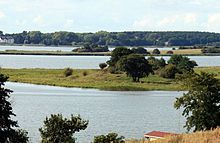
Isolated archaeological settlement finds date back to the Mesolithic . The finds from the Neolithic are numerous , more than 500 settlements that have been found indicate a lively settlement on the island. However, only near Lütow on the Gnitz peninsula has a large stone grave been preserved. In the Bronze Age , Usedom benefited from its location on the Oderweg, which was an important north-south trade route from the Mediterranean to the Scandinavian region. The castle wall on the Golm is a ground monument from the transition period from the Young Bronze Age to the Early Iron Age . Considered the northernmost place of a group of fortifications along the Oder , it is ascribed to the Lusatian culture . Since the 1970s, an independent culture has been assumed for the islands of Usedom and Wolin , the Usedom-Wolliner Group. Many archaeological finds show that the islanders exchanged amber , which was coveted in ancient times and is found on the coast of Usedom, for objects of daily use and bronze jewelry. In 1975, during excavation work near Ückeritz, a horse-drawn decoration consisting of 110 individual parts was found, which is associated with the Bronze Age sun cult. During the time of the Great Migration , the Germanic tribes of the Oder estuary gave way to a Wendish-Slavic settlement, from which most of the place names on the island come and which has an impact on local customs. In the Wendish era, the island was already densely populated and well-organized. Structural relics from that time are, for example, the castle walls near Neppermin , Mellenthin and Stolpe .
Since the 10th century there was a Slavic castle settlement near the later town of Usedom. The "Urbs Osna" was destroyed by the Danes around 1115/1119. "Urbs Osna" is mentioned in connection with the conquest of the area by the first Duke of Pomerania , Wartislaw I, and with the missionary work he initiated by Bishop Otto von Bamberg . The latter had the Wendish greats come together on the castle wall on Pentecost Sunday in 1128 and converted them to Christianity. A cross erected on the castle wall of Usedom in 1928 commemorates the takeover of Christianity by the Slavs of the island and the adjacent West Pomeranian mainland.
The castle was rebuilt around 1159 and a market town was created at the same time. Until the middle of the 13th century, the place was one of the favorite residences of the Dukes of Pomerania. After that it lost this importance in favor of Wolgast and Stettin . In the first half of the 13th century, after decades of fighting between the Slavic inhabitants and the Danes, the immigration of German settlers began. New villages with hooves and three-field farming arose . Nobles of German and Slavic origin settled on feudal rights. In place of the large Slavic settlement of Usedom, the German town of Usedom was established, which was given the town charter in 1298. Around 1155 the Premonstratensian monastery ( Grobe monastery ) was founded near Usedom , which was moved to Pudagla in 1308 . During the Middle Ages, the Grobe monastery acquired considerable parts of the island. It was incorporated into the Duchy of Pomerania during the Reformation in 1535 and converted into a ducal office.
17th and 18th centuries
After the Thirty Years' War , Usedom fell to Sweden along with the rest of Western Pomerania and the entire Oder estuary including the neighboring island of Wollin and became part of Swedish Pomerania . However, the Swedish king only ruled there as Duke of Pomerania , and the area remained part of the Holy Roman Empire of the German Nation . Between 1648 and 1720 the island of Usedom was the scene of armed conflicts between Brandenburg-Prussia and Sweden on several occasions . As a result of the Great Northern War (1700–1721), the island, which had been under Prussian sequestration since 1713, together with other Western Pomerania areas, finally came to Prussia .
In the first half of the 18th century, the Prussian crown's economic and political efforts led to the expansion of the previously difficult-to-pass Świnoujście, and in 1764 at its mouth the Świnoujście was founded . The new shipping route made the access to Stettin independent of the old route, still controlled by Sweden, over the Peene River past Wolgast.
19th century

During the Prussian administrative reforms in 1818, the two islands of Usedom and Wollin became the district of Usedom-Wollin with Swinemünde as the district town. In 1824 and 1825, respectively, bathing began in Swinemünde and Heringsdorf, followed by Koserow , Zinnowitz and Ahlbeck by the middle of the 19th century . The heyday of the seaside resorts only began after the establishment of the empire in 1871. With the construction of the Kaiserfahrt in the mouth of the Swine, the village of Kaseburg became an island between the canal and the Swine.
The increasing bathing tourism, especially from the relatively close Berlin, prompted the construction of the Ducherow-Heringsdorf-Wolgaster ferry branch off the Berlin-Prenzlau-Stralsund railway line near Ducherow . As far as Swinoujscie, apart from the rail-free railway embankment and a few station buildings, only the ruins of the steel lift bridge at Karnin remain.
20th and 21st centuries
Until 1945
In the period after the First World War, the administration of the Zinnowitz seaside resort endeavored to make the place a “ Jew-free bath ”, so that as early as 1928, a travel guide warned Jewish guests against visiting Zinnowitz. After the seizure of power by the Nazis Jewish tourists were completely displaced from the beaches of the island.
During the Second World War , the Peenemünde Army Research Center was located in Peenemünde , a test site for missiles, the Peenemünde-West Air Force test site and a naval base in Swinoujscie. The air raids of the Royal Air Force and the United States Army Air Forces from 1943 to 1945 were targeted at these facilities , with the attack on Swinoujscie in the midday of March 12, 1945, leading to many deaths, especially among the refugees from the east jammed there . The dead were buried in mass graves on the Golm elevation near Kamminke, right on today's border. There is a memorial there. In 2005 the Volksbund Deutsche Kriegsgräberfürsorge opened an international youth meeting place.
1945–1990
At the Potsdam Conference , with the establishment of the German-Polish border, it was decided to place Świnoujście under Polish administration. The official handover by the District Administrator of the Usedom-Wollin district - from then on only the Usedom District - took place on October 6, 1945 in the presence of representatives of the Soviet occupying power. In 1950 the GDR recognized the new border in the Görlitz Agreement . In 1990, the German-Polish border treaty was recognized by the Federal Republic .
From 1945 to 1949 the part of the island that remained with Germany existed from an administrative point of view as the district of Usedom in the Soviet occupation zone, from 1949 to 1952 in the GDR. From October 1945 to March 1946, the seat of the district administration was Bansin, then Ahlbeck, where the Soviet district headquarters previously located in Świnoujście had been relocated in October 1945. With the administrative reform of the summer of 1952, the district of Usedom and parts of the adjacent mainland, which had previously belonged to the district of Greifswald , became the new district of Wolgast, with the district administration in the city of the same name . 1994 this group was with the circles Anklam and Greifswald to Ostvorpommern together, the seat of the city Anklam was. Since the district reform in 2011 , the island has been part of the Vorpommern-Greifswald district.
After the Second World War, tourism remained the most important branch of the economy alongside agriculture and fishing. In 1953, most of the private hotels and pensions were confiscated or expropriated in the " Aktion Rose ". State-owned companies from all over the GDR, the FDGB holiday service and state institutions took over the facilities.
Many islanders found work as commuters in Wolgast at the Peene shipyard , which in the time of the GDR mainly carried out armaments contracts. The military was also an important employer. In the north of the island, the NVA took over the old military facilities in Peenemünde and Karlshagen from the Red Army , which became a naval and air force base. There were also NVA units in Pudagla. Units of the Red Army were stationed in Garz, where there was also an NVA flight training squadron from 1988 to 1990.
Since 1990
After German reunification in 1990, all army locations on Usedom were dissolved. The Peene shipyard laid off most of its original 4,000 employees. The hotel industry suffered from unresolved property issues in the early years. The number of overnight stays in Usedom accommodation fell drastically after 1990, especially since many facilities did not meet the higher western international standards. Since then, attempts have been made to reconcile economic and ecological concerns in tourism on Usedom. The oil production in Lütow was continuously reduced. In Peenemünde, according to unofficial statistics, 75 percent of the population were temporarily unemployed.
After a few setbacks, the economy on Usedom recovered, especially the tourism industry.
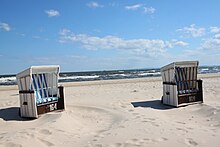
At the moment, the German part of Usedom lives mainly from tourism. Young people almost only find work in hotels, restaurants and other tourist facilities as well as in retail, which, according to surveys and analyzes, is paid too little.
tourism
On the coast
With the Baltic seaside resorts of Karlshagen , Trassenheide , Zinnowitz, Zempin , Koserow , Loddin , Ückeritz and the imperial baths ( Heringsdorf , Bansin and Ahlbeck ) on the German side and Świnoujście in Poland, the island is of great importance for tourism in both countries. In addition to the sandy beaches on the Baltic Sea, the seaside architecture and the port of Świnoujście with its lively shipping traffic attract visitors to the coast. There are numerous hotels , guest houses , holiday apartments and campsites in the places mentioned . There are also leisure facilities such as a butterfly farm (Trassenheide), riding stables and handicraft businesses (Heringsdorf beach chair manufacture), a climbing forest, museums and a number of cultural and children's activities.
The largest employer on the island of Usedom is the SEETELHOTELS hotel group .
In the hinterland
In addition to the amber baths, imperial baths and the other seaside resorts on the Baltic Sea, the inland lakes (freshwater lakes) on the island such as Schmollensee , Gothensee or Wolgastsee are attractions for tourism .
In the hinterland there is the small town of Usedom , villages with mansions ( Mellenthin , Stolpe Castle ), thatched-roof houses and windmills ( Benz , Pudagla , Trassenheide, Kamminke ), the old lift bridge Karnin , the Lieper Winkel and Gnitz peninsulas , which frame the backwaters . Bicycle tours are popular on the island, both in the hinterland along the backwater and on the coast. The off-season tourism is to be stimulated with the support of EU funds from the EAFRD program.
The southern part of the island between Achterwasser and Stettiner Haff is advertised for tourists as Achterland (Low German for hinterland ).
Piers
There are an unusually large number of piers on the Usedom Baltic Sea coast.
Ahlbeck pier from 1882
traffic

with branch line to Peenemünde
Rail transport
Usedom is connected to the main line Berlin-Stralsund via the Züssow – Wolgast Hafen railway , the Wolgast Peenebrücke and the Ducherow – Heringsdorf – Wolgaster ferry between the Wolgast ferry and Świnoujście (Swinoujscie), which has been preserved or rebuilt . The railway is operated by the Usedomer Bäderbahn (UBB). Since September 2008, she moves back into the center of Swinoujscie and the state of Mecklenburg-Vorpommern , as well as the city of Swinoujscie endeavors, the original mainland port on the Karniner bridge to be recovered, making it the route for the Federal Transport Infrastructure Plan 2030 has filed . A branch line branches off from Zinnowitz on a former industrial railway track off to Peenemunde.
In the Federal Transport Infrastructure Plan 2030, the restoration of the Ducherow – Swinoujscie railway line was included in the category “Additional requirements / international projects”. The bridge at Karnin is to be rebuilt for the new line to be built . The trains are to be operated electrically and run on one track at a maximum of 120 km / h. If a Świna tunnel is built as part of the “Usedom Crossing” project , it could also accommodate a railway track, which would close the gap between the two stations in Świnoujście and allow rail travelers from Usedom to travel on to the Scandinavian ferry on Wolin and to the Polish mainland.
Bus transport
The Usedomer Bäderbahn (UBB) operates local public transport on the street. In addition, the UBB uses a long-distance bus fleet that runs to and from Rostock, Hamburg and Berlin. Komunikacja Autobusowa Sp.z oo buses operate in the Polish part of the island
Bicycle traffic
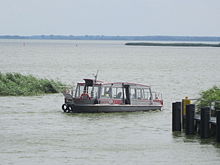
Usedom has a well-developed network of cycle paths. The twelve-kilometer-long Europa-Promenade in the east through the three Kaiserbad districts Bansin, Heringsdorf and Ahlbeck and through Świnoujście is continuously passable. In west direction, paved bike paths lead along the coast to Peenemünde in the north-west of Usedom. Most of the hinterland is accessible via bicycle paths, local roads and country roads.
Usedom is also connected to some national and international bike trails, including a. to the Baltic Sea Cycle Route (as EuroVelo route EV 10 circles the Baltic Sea and connects Usedom with cities such as Riga, Gdansk, Saint Petersburg, Stockholm and Copenhagen) and the Berlin-Usedom long-distance cycle route (including via Anklam, Pasewalk and Prenzlau).
Cyclists and pedestrians can also use the ferries Altwarp or Ueckermünde - Świnoujście, Altwarp or Ueckermünde - Kamminke, Kamp - Karnin, Freest - Kröslin - Peenemünde and Gager ( Rügen ) - Peenemünde on the island of Usedom. Pedestrians can use the Lassan - Zinnowitz shipping line (backwaterside).
Motorized private transport


On the road, the German part of the island in the north-west can be reached on the federal highway 111 from the Gützkow junction of the federal highway 20 via the Peenebrücke Wolgast . In the south-west the access is on the federal highway 110 from the junction Jarmen of the A20 over the Zecheriner bridge behind Anklam . Both bridges are bascule bridges . The federal highways are the main axes of inland traffic on the island. A bypass of the B 111 near Wolgast with a new bridge has already been taken into account in the Federal Transport Infrastructure Plan 2003 in the category “urgent need”. In the 2014 Federal Transport Infrastructure Plan, it is categorized as a “project to be examined”. As early as 2010, the Regional Planning Association of Western Pomerania determined that the "depicted route corridor [...] is environmentally friendly according to the test results available". Plans for the construction of bypasses near Usedom and Zirchow in the course of the B 110 are critically commented on in the "Regional Spatial Development Program Western Pomerania" under aspects of environmental and nature conservation.
There is no road connection via the Swine, so the Polish part of Usedom can be reached from the east via the island of Wolin and two car ferries . The northern ferry is mostly reserved for vehicles with the registration number " ZSW ". A plan drafted in 1957 to build a nine-kilometer-long dam between the southern tip of Usedom near the Kanał Piastowski (the Kaiserfahrt) and Nowe Warpno (Neuwarp) across the Szczecin Lagoon, on which motor vehicles and trains should run and through which one direct Land connection to Świnoujście through Polish territory was not put into practice. The planned Świnatunnel ("Usedom Crossing") would connect Usedom and Wolin in the event of ice, storms or floods, thus shortening the time required for vehicles to travel to the Usedom part of the city of Świnoujście from the east. A political majority in favor of heavy goods transit traffic from the A 20 across Usedom to Świnoujście remains questionable . After the opening of the two border crossings at Ahlbeck and Garz, only vehicles with a maximum gross vehicle weight of 7.5 t are allowed to use them. The easternmost section of the B 110 is also unsuitable for vehicles over 7.5 t due to its expansion status.
Air traffic
Heringsdorf Airport , where aircraft up to the size of an Airbus A320 can land, is located in the town of Garz near the Polish border . The range of flights includes domestic and international scheduled and charter flights for vacationers and business travelers as well as sightseeing flights in the region.
The Peenemünde airfield is somewhat larger and has only been used as a special landing pad for small aircraft since the NVA ended its military use .
Near Mellenthin, the Usedomer Fliegerclub operates a landing pad on a former agricultural airfield that can be approached by microlight aircraft and used by hang-gliders and model aircraft as well as for parachuting.
shipping
From the piers in Bansin , Heringsdorf and Ahlbeck, as well as departure points to the west, bath ships go to Świnoujście and Międzyzdroje (Misdroy) in Poland. The trips are carried out by the Adler ships . From the port in Świnoujście-Warszów on Wolin there are ferry connections of the Unity Line to Ystad and Trelleborg in Sweden .
There are marinas and yacht harbors in Kamminke , Karlshagen , Krummin, Peenemünde, Ückeritz (with Stagnieß), Zinnowitz and Usedom-Stadt (Karnin and city harbor) on the Achterwasser , in Wolgast on the Peenestrom , in Anklam on the Peene , and in Świnoujście on the Świna. There is no port directly on the outer coast of Usedom in 2016, but one is planned with direct access to the Sack Canal east of the Schloonsee in Bansin / Heringsdorf. First of all, the Engie company premises should be relocated from Lake Schloonsee to the Bansin sewage treatment plant or the former Soviet barracks in Ahlbeck. Originally a marina at the Heringsdorf pier was planned, but was initially discarded due to logistical challenges.
Culture
Cultural sites
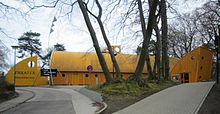
The Ostseebühne Zinnowitz of the Vorpommerschen Landesbühne Anklam with 1300 seats has been the annual venue of the Vineta Festival since 1997 . Immediately next to the open-air stage, the venue of the festival, is the “Theater Blechbüchse”, which has also been the location of the state stage since 1997. This also operates the theater tent Chapeau Rouge in Heringsdorf. Classical and contemporary pieces have been shown there every summer since 1991. The facilities of the Landesbühne on Usedom are also available for lectures and other cultural events.
The " Harbor Festival " has been taking place at the port of the city of Usedom since 2008 . In 2017, the summer theater of the Vorpommerschen Landesbühne was relocated to Wolgast on the Schlossinsel, where it has been inviting to entertaining open-air theater events under the name "Schlossinsel Festival".
As in the German seaside resorts, there is a concert shell in Świnoujście; In 2010, an open-air stage was opened in the port city with a capacity of 3500 spectators.
Usedom in art
Usedom is a popular panorama for paintings , literary works, documentaries , music videos and feature films .
literature
During the period of emerging tourism in the first half of the 19th century, the popular Berlin writer Willibald Alexis had a summer house built in Heringsdorf. The Krummin pastor Wilhelm Meinhold (1797-1851) published his novel Maria Schweidler, the Amber Witch in 1843 . The fictional story, the plot of which is set at the time of the Thirty Years' War, was a sales success. Theodor Fontane (1819–1898) spent parts of his childhood and youth in Swinoujscie. He published his memoirs in 1893 in his autobiographical novel Meine Kinderjahre . Swinoujscie was the model for the Pomeranian district town of Kessin, described in his novel Effi Briest (1894/1895) .
The Villa Irmgard Museum in Heringsdorf commemorates the stay of the Russian writer Maxim Gorki in 1922 . The writer Hans Werner Richter from Neu Sallenthin near Bansin , founder of Group 47 , described life on the island in the first half of the 20th century in various autobiographical novels (footsteps in the sand , Bansin stories , the hour of false triumphs) . After his death in 1993, the Hans-Werner-Richter-Haus in Bansin was dedicated to him.
painting
One of the first known artists on the island of Usedom, the painter Elsa von Corswant (1875–1957), came from Krummin . In addition to portraits, she created genre pictures and landscape pictures of the Usedom hinterland that can be assigned to the impressionistic open-air painting.
The important expressionist US-German artist Lyonel Feininger spent his summer months on the island from 1908 to 1921 and immortalized numerous motifs in his works. In his honor, the Feininger Tour cycle path was laid out over parts of the island.
From 1933 the painter Otto Niemeyer-Holstein came to Usedom regularly in summer. In 1939 he settled on the Achterwasser between Zempin and Koserow. His home and studio in Lüttenort are now accessible as a memorial and gallery. With Karen Schacht , Herbert Wegehaupt and Otto Manigk , three other painters settled in Ückeritz in the 1930s and 1940s. In the 1950s, Susanne Kandt-Horn and Manfred Kandt as well as Vera Kopetz followed their example. The painters Matthias Wegehaupt and Oskar Manigk currently live and work in Ückeritz.
Usedom is one of the most famous artist colonies .
Movies
Usedom became known throughout Germany as a film set through the Loriot comedy Pappa ante portas from 1991, the Ahlbeck pier is one of the locations and was restored especially for the film. In 2010, parts of the award-winning blockbuster The Ghostwriter were shot on Usedom. In autumn 2014 the first episode Mörderhus of the ARD - crime series Der Usedom-Krimi , directed by Andreas Herzog, was broadcast.
music
The German-speaking pop-rock band Jennifer Rostock is one of the most famous musicians from the island of Usedom . A platform for young musicians and various bands is the annual "Use Tube" series of events in July in the concert shells of the three imperial baths Ahlbeck, Bansin and Heringsdorf.
As the sounding podium of the Baltic Sea , the Usedom Music Festival has been presenting the musical life of all countries around the Baltic Sea since 1994 with an annually changing country focus. This form of artistic collaboration and musical dialogue has already brought world-famous soloists, conductors and ensembles to the island of Usedom. Mstislaw Rostropowitsch , Kurt Masur , the Kremerata Baltica, the Esbjörn Svensson Trio , Kristjan , Paavo and Neeme Järvi or Esa-Pekka Salonen and many more presented the music of their countries to an interested audience. The programs of the Usedom Music Festival cover a wide spectrum. Concerts take place in churches, hotels, studios and in industrial halls on the German and Polish side of the island of Usedom. The annual highlights include the Peenemünde concerts in the historic power plant on the grounds of the Peenemünde Historical-Technical Museum with the Baltic Sea Philharmonic and the NDR Elbphilharmonie Orchestra .
See also
literature
- Wilhelm Ferdinand Gadebusch: Chronicle of the island of Usedom. Dietze, Anklam 1863, online .
- Gösta Hoffmann, Reinhard lamp: The island of Usedom - late Pleistocene and Holocene landscape development. In: Reinhard Lampe, Sebastian Lorenz (Ed.): Ice Age Landscapes in Mecklenburg-Western Pomerania . Verlag Geozon Science Media, Greifswald 2010, ISBN 3-941971-05-0 , p. 92 ff.
- Rainer Höll: Magical Usedom with Greifswald and Stettiner Haff . Nordlicht verlag, Ostseebad Karlshagen 2012, ISBN 978-3-9809640-5-0 .
- Martin Kaule: Usedom Island 1933–1945. Places of history . Ch. Links Verlag, Berlin 2018, ISBN 978-3-86153-997-1 .
- Bernfried Lichtnau: Usedom. Forays into the history, architecture and art of the island. Dietrich, Peenemünde 1996, ISBN 3-930066-28-9 .
- Erwin Rosenthal: Usedom and Wollin. Two sister islands in the Pomeranian Bay . Demmler-Verlag, Ribnitz-Damgarten 2013, ISBN 978-3-944102-02-3 .
- Dirk Schleinert : The history of the island of Usedom . Hinstorff-Verlag, Rostock 2005, ISBN 3-356-01081-6 .
- Hans Christof Wächter, Heinz Teufel : Usedom. A journey in pictures , Ellert & Richter-Verlag, Hamburg 1991, ISBN 3-89234-277-6 .
- USEDOM exclusiv magazine, nordlicht verlag Karlshagen, for the online edition of the USEDOM exclusiv magazine
Web links
- Literature about Usedom in the state bibliography MV
- Official tourist information website of the island of Usedom (Usedom Tourismus GmbH)
- www.usedom-exclusiv.de - Online edition of the USEDOM exclusiv magazine
- Birgit Walter: room with sea view and full board for 5.11 marks . In: Berliner Zeitung , July 11, 2009.
- ( Page no longer available , search in web archives: Integrated traffic development concept Usedom-Wollin 2015 )
- ( Page no longer available , search in web archives: regional development planning around the Stettiner Haff . Diploma thesis 2005 )
Individual evidence
- ^ Usedom Tourismus GmbH
- ↑ a b Tourism Association Island of Usedom
- ↑ Infographic of the week: These are Germany's most popular vacation islands. In: Spiegel Online . July 6, 2016, accessed June 9, 2018 .
- ↑ Usedom's European promenade: island opens cross-border, climate-neutral, longest beach promenade in Europe ( page no longer available , search in web archives ) Info: The link was automatically marked as defective. Please check the link according to the instructions and then remove this notice.
- ↑ Hans Christof Wächter, Heinz Teufel: Usedom. Ellert & Richter Verlag 1991, ISBN 3-89234-277-6 , p. 19.
- ^ Gösta Hoffmann, Reinhard lamp: The island of Usedom - late Pleistocene and Holocene landscape development . In: Reinhard Lampe, Sebastian Lorenz (Ed.): Ice Age Landscapes in Mecklenburg-Western Pomerania . Verlag Geozon Science Media, 2010, ISBN 3-941971-05-0 , p. 93.
- ↑ The more weather, the better | Discover Germany | German wave
- ↑ Time series of the German Weather Service , (data output as XLS)
- ↑ Regional Spatial Development Program Vorpommern (RREP) 2010 ( Memento of the original from September 24, 2015 in the Internet Archive ) Info: The archive link was inserted automatically and has not yet been checked. Please check the original and archive link according to the instructions and then remove this notice. - Central local structure with regional, medium and basic centers, accessed on July 12, 2015
- ↑ Traditional craft meets arts and crafts ( Memento from July 14, 2015 in the Internet Archive ), usedom.de, March 10, 2015
- ↑ Ernst Eichler and Werner Mühlmer: The names of cities in Mecklenburg-Vorpommern. Ingo Koch Verlag, Rostock 2002, ISBN 3-935319-23-1
- ↑ The name Usedom . In: The folk tales of Pomerania and Rügen. Pp. 171-172 (1840)
- ↑ Dirk Schleinert : The history of the island of Usedom. Hinstorff, Rostock 2005, ISBN 3-356-01081-6 , pp. 12-13.
- ↑ Dirk Schleinert : The history of the island of Usedom. Hinstorff, Rostock 2005, ISBN 3-356-01081-6 , p. 13.
- ↑ Hans-Christof Wächter, Heinz Teufel: Usedom. Ellert and Richter, Hamburg 1991, ISBN 3-89234-277-6 , p. 20.
- ↑ Hans-Christof Wächter, Heinz Teufel: Usedom. Ellert and Richter, Hamburg 1991, ISBN 3-89234-277-6 , p. 20.
- ↑ Dirk Schleinert : The history of the island of Usedom . Hinstorff Verlag, Rostock 2005, ISBN 3-356-01081-6 , p. 132.
- ↑ Wolfgang Bayer: Germany in the firestorm: The planned inferno . Spiegel Special 1/2003. April 1, 2003
- ^ Tourism: Indian toilets . In: Der Spiegel . Edition 32/1992. P. 97 f.
- ↑ Wiltrud Zweigler: Sea eagles and tourists are guests . In: Berliner Zeitung . October 11, 1995
- ↑ Vorpommern: gone without replacement . In: Der Spiegel . Edition 46/1991. November 11, 1991, pp. 100-103
- ↑ cf. Millions in the sand. Of fortune-tellers and property dealers on the island of Usedom . In: Der Spiegel . Edition 38/1995. September 18, 1995. pp. 140 f. and dump of good hope . In: Der Spiegel . Issue 39/1997. P. 76 ff.
- ↑ Conservation: Pandora's Box . In: Der Spiegel issue 28/1994. July 11, 1994. p. 74
- ^ [Tourism kick-off in Mecklenburg-Western Pomerania], country report by Deutschlandradio Kultur , April 15, 2013
- ↑ The 100 largest employers in Mecklenburg-Western Pomerania 2012 , NordLB, accessed on February 22, 2014
- ↑ The Achterland on Usedom. In: info-mv.de. Retrieved March 24, 2017 .
- ↑ Usedom Achterland - Untouched nature of the island. (No longer available online.) In: ubb-online.com. Formerly in the original ; accessed on March 24, 2017 . ( Page no longer available , search in web archives ) Info: The link was automatically marked as defective. Please check the link according to the instructions and then remove this notice.
- ↑ Usedom wants fast rail connections to Berlin . In: Berliner Morgenpost , January 4, 2015
- ↑ Federal Ministry of Transport and Digital Infrastructure: Overview of the ongoing projects and the projects proposed for the Federal Transport Infrastructure Plan. Federal railways . ( Memento of the original from July 3, 2015 in the Internet Archive ) Info: The archive link was inserted automatically and has not yet been checked. Please check the original and archive link according to the instructions and then remove this notice. February 9, 2015. p. 4
- ↑ Federal Ministry of Transport and Digital Infrastructure: Overview of the ongoing projects and the projects proposed for the Federal Transport Infrastructure Plan. Federal railways . ( Memento of the original from July 3, 2015 in the Internet Archive ) Info: The archive link was inserted automatically and has not yet been checked. Please check the original and archive link according to the instructions and then remove this notice. February 9, 2015. p. 37.
- ↑ Alexander Vogt: Financing Perspectives “Usedom Crossing” from the point of view of the European Parliament (lecture). Świnoujście, April 26, 2014.
- ↑ translator2: EuroVelo 10 - EuroVelo. Retrieved May 4, 2017 .
- ↑ The Berlin-Usedom long-distance cycle path. Retrieved May 4, 2017 .
- ↑ Federal Ministry of Transport and Digital Infrastructure: Overview of the current projects and those proposed for the Federal Transport Infrastructure Plan for federal highways ( memento of the original from 23 September 2015 in the Internet Archive ) Info: The archive link was inserted automatically and has not yet been checked. Please check the original and archive link according to the instructions and then remove this notice. . September 5, 2014. p. 20
- ^ Regional Planning Association Vorpommern (RPV): Regional Spatial Development Program Vorpommern. Environmental Report 2010 ( Memento of the original from September 24, 2015 in the Internet Archive ) Info: The archive link was inserted automatically and has not yet been checked. Please check the original and archive link according to the instructions and then remove this notice. . P. 38 f.
- ^ Regional Planning Association Vorpommern (RPV): Regional Spatial Development Program Vorpommern. Environmental report 2010 . ( Memento of the original from September 24, 2015 in the Internet Archive ) Info: The archive link was inserted automatically and has not yet been checked. Please check the original and archive link according to the instructions and then remove this notice. P. 79 ff. And 171
- ↑ Swinoujscie Dam? In: The time . May 9, 1957
- ↑ Baltic Portal : Ten applicants for Swine tunnel tender August 27, 2014
- ↑ Destinations Usedomer Airport
- ↑ Usedom Aviation Club. Retrieved August 22, 2015 .
- ^ Marina am Schloonsee in Heringsdorf , concept by Dr. Wulf Böttger and Tankred Lenz, July 1, 2013
- ^ Bansin / Heringsdorf: Luxury marina planned in the imperial baths , Ostsee-Zeitung , March 9, 2016
- ^ Usedom Tourismus GmbH: Theater on Usedom
- ^ Hans Jürgen Reichardt: Events Swinoujscie Świnoujście
- ↑ Usedom artists' colony
- ↑ Filmland MV - Filmlocations ( Memento of the original from November 4, 2014 in the Internet Archive ) Info: The archive link was inserted automatically and has not yet been checked. Please check the original and archive link according to the instructions and then remove this notice. , Filming locations on Usedom, accessed on November 4, 2014
- ↑ Location Usedom (Germany) - Films and Series , accessed on June 27, 2015
- ↑ Use Tube - young bands & musicians in the imperial baths ( memento of the original from June 29, 2015 in the Internet Archive ) Info: The archive link was automatically inserted and not yet checked. Please check the original and archive link according to the instructions and then remove this notice.
